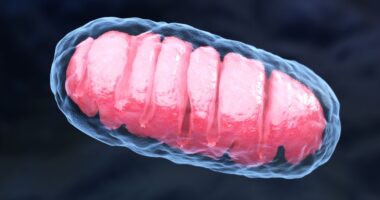Study: Mitochondrial Fragmentation May Be Therapeutic Target in CMT2B
Abnormalities in cells' powerhouses may contribute to disease

Rab7A, the faulty enzyme behind Charcot-Marie-Tooth disease type 2B (CMT2B), regulates the structure and movement of mitochondria, the cells’ powerhouses, according to a new study in patient-derived and mouse cells carrying a CMT2B-causing mutation.
Also, the mutated Rab7A enzyme was found to promote mitochondrial fragmentation — the breakup of mitochondria that occurs in aging and disease — through the activation of a protein called Drp1. In turn, Drp1 suppression was shown to rescue mitochondrial defects.
These findings shed light on CMT2B’s underlying mechanisms and point to mitochondrial fragmentation as a potential therapeutic target for this disease, the researchers noted.
The study, “Mitochondria dysfunction in Charcot Marie Tooth 2B Peripheral Sensory Neuropathy,” was published in the journal Communications Biology.
An inherited disease, CMT2 is characterized by the degeneration of axons — nerve fibers that transport signals to the next nerve or muscle cell — of the peripheral nervous system. The peripheral nerves control movement and sensation in the limbs.
People with the CMT2B subtype experience sensory loss, progressive muscle weakness, and ulcers in the hands and feet. Symptoms typically start in the second or third decade of life.
CMT2B is caused by mutations in the RAB7A gene, which provides instructions to produce Rab7A, a small enzyme whose activation state depends on the molecule to which it is bound.
This enzyme was shown in previous studies to be involved in the processes of cellular waste breakdown and recycling — and in several processes specific to nerve cells (neurons), such as the transport of molecules and neuronal migration during development.
Understanding mitochondrial fragmentation
While evidence suggests that Rab7A also is implicated in the regulation of mitochondrial structure, movement, and function, the impact of CMT2B-causing RAB7A mutations on mitochondrial features remains unclear.
Mitochondria are membrane-enclosed structures within cells that regulate energy production, cell growth, and cell death. Mitochondrial function depends on their structure and dynamics, and the formation of new mitochondria.
To learn more about the underlying mechanisms of these mitochondria, a team of researchers in the U.S., Italy, and China now sought to analyze their structure and movement. The team used mitochondria in lab-grown skin fibroblasts from CMT2B patients and different cell types from a mouse model. All were carrying the same disease-causing RAB7A mutation, V162M.
Fibroblasts, the main cell type in connective tissue, are involved in wound healing and tissue regeneration. The V162M mutation, along with CMT2B-causing mutations, results in a mutated Rab7A enzyme more prone to be bound to its activator molecule.
The analysis showed that mitochondrial size and network complexity were significantly reduced in both patient-derived and mouse fibroblasts producing the mutated Rab7A, indicating an increase in mitochondrial fission, or fragmentation.
This was accompanied by a significant increase in active Drp1, the protein that promotes mitochondrial fragmentation.
Given previous studies showing that Rab7A activates Drp1, the researchers next evaluated the effects of suppressing either Drp1 or Rab7A’s binding sites in the lab-grown mouse fibroblasts.
Treatment with either blocker was found to normalize mitochondrial fragmentation and restore mitochondrial network complexity in these cells.
Notably, similar mitochondrial defects were observed in lab-grown peripheral sensory neurons from the mouse model, and these also were rescued upon treatment with the Drp1 blocker.
In addition, these neurons showed a significant increase in the number of moving mitochondria and in their moving speed.
The role of Rab7A
The researchers found no significant changes in mitochondrial structure, function, or movement in Rab7A-mutated mouse nerve cells from the central nervous system, or CNS, which is comprised of the brain and spinal cord. This was consistent with the absence of CNS-related symptoms in CMT2B patients.
However, since Rab7A is produced throughout the body, this difference may be explained by the production of peripherin, a Rab7A-interacting structural protein, primarily in peripheral neurons, the team hypothesized.
Binding between Rab7A and peripherin may lead to “the destabilization of axonal structure,” which “will significantly impact axonal function and perhaps the mitochondrial morphology and function,” the researchers wrote.
Moreover, while the reasons behind the observed mitochondrial defects in fibroblasts are currently unclear, these abnormalities “may impair the ability for skin wound repair, contributing to the fact that CMT2B patients are more prone to skin ulcers,” the team wrote.
Overall, these findings establish that Rab7A “plays an important role in regulating mitochondrial morphology and function,” the researchers wrote.
They also suggest that CMT2B is associated with mitochondrial defects that are mediated by the increased binding of mutant Rab7A to its activator, which leads to Drp1 overactivation.
“Targeting mitochondrial fragmentation provides a promising therapeutic strategy for treating CMT2 diseases as demonstrated elegantly by a recent study,” the team wrote.
“It will be interesting to test if a similar strategy will be effective in treating CMT2B in future studies,” they added.
Since Rab7A “is involved in many other important facets of cellular processes,” future studies are needed to understand “how these processes are impacted by CMT2B related Rab7 mutations,” the researchers concluded.








